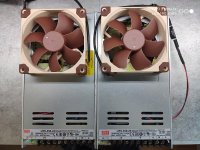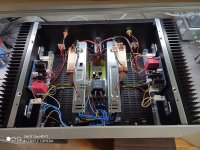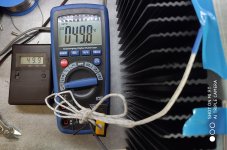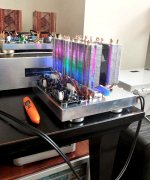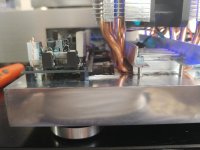AN final build
This is my AN final build.
I removed the ‘mean’ 12V fans form the noisy MeanWell LRS-350-24 SMPS and replaced them with 92mm Noctua NF-A9 FLX using the ultra-low noise adapter NA-RC12 to reduce the speed to ~1000rpm. I use the SMPS on/off logic to manage the fans. No need for PWM adapter nor additional contraptions.
The result is fantastic: no noise, just great music!
Thanks again Hugh and X for this great project and the forum members for fruitful discussions.
Cheers,
Jacques
This is my AN final build.
I removed the ‘mean’ 12V fans form the noisy MeanWell LRS-350-24 SMPS and replaced them with 92mm Noctua NF-A9 FLX using the ultra-low noise adapter NA-RC12 to reduce the speed to ~1000rpm. I use the SMPS on/off logic to manage the fans. No need for PWM adapter nor additional contraptions.
The result is fantastic: no noise, just great music!
Thanks again Hugh and X for this great project and the forum members for fruitful discussions.
Cheers,
Jacques
Attachments
Jacques,
Excellent AN build! Nice work getting the SMPS supplies to work more quietly with your fan modifications. How hot do the AN heatsinks get? Is there any background noise/hum from speakers?
ENJOY!!
Excellent AN build! Nice work getting the SMPS supplies to work more quietly with your fan modifications. How hot do the AN heatsinks get? Is there any background noise/hum from speakers?
ENJOY!!
Jacques,
Excellent AN build! Nice work getting the SMPS supplies to work more quietly with your fan modifications. How hot do the AN heatsinks get? Is there any background noise/hum from speakers?
ENJOY!!
Thanks Vunce!
The heatsinks are quite hot, I would say around 55°C. One of my DMMs came with a temperature sensor but I still have to find it .... The AN is amazingly silent. No hum or hiss even if I stick my ear to the woofer or tweeter. It is more silent than my vintage Proton AM-20 (a little hissy) or my DIY P3A and DIY gainclone LM3886 (both with a tiny bit of toroid hum). I use them mostly for near-field listening so the absence of noise is important. AN heat might be a concern this summer though... we'll see.
Pease tell us more about your AN listening experience!
Cheers,
Jacques
Very very nice result, Jacques! Great work on the Noctua fan for the Meanwell. Simply the way to go for no fuss modern power supply. The AN is absolutely quiet and that is how I like my amps!
So you just feed the 12v DC from the SMPS fan drive to power the PWM Noctua fan drive?
I can’t stand amps with even a tiny bit of hum.
Edit: I see the FLX option is a 12v non PWM version. Nice.
So you just feed the 12v DC from the SMPS fan drive to power the PWM Noctua fan drive?
I can’t stand amps with even a tiny bit of hum.
Edit: I see the FLX option is a 12v non PWM version. Nice.
Last edited:
Agree with X, Jacques!
Very nice, well built AN!
Do you find the heatsinking on the outputs sufficient?
Good wiring. How much are the mounting holes on the outputs, is that a 300mm x 150mm heatsink?
Hugh
Very nice, well built AN!
Do you find the heatsinking on the outputs sufficient?
Good wiring. How much are the mounting holes on the outputs, is that a 300mm x 150mm heatsink?
Hugh
Agree with X, Jacques!
Very nice, well built AN!
Do you find the heatsinking on the outputs sufficient?
Good wiring. How much are the mounting holes on the outputs, is that a 300mm x 150mm heatsink?
Hugh
Thanks Hugh and X!
The outputs were positioned on the heatsink using the golden rule (...of thumb 😀). The heatsinks are 300x160x40mm Dissipante 4U.
I measured with two devices the temperature (no input) which seemed to stabilize just below 50°C after 100min (ambient 25°C).
Do you think this is within acceptable limits?
Cheers,
Jacques
Attachments
YES Jacques, it couldn't be better!
Only 25C above ambient is very good and the devices will last at least 20 years.
Have you had a good listen? How does the quality compare with other amps of your experience?
HD
Only 25C above ambient is very good and the devices will last at least 20 years.
Have you had a good listen? How does the quality compare with other amps of your experience?
HD
My AN has been playing music whole day.
I quickly put together a PSU made of two laptop PSUs:
HP HSTNN-DA12: 19.5V, 11.8A each.
Excellent, big PSUs, available on Ebay for $20. Silent, no active cooling needed (in theory).
Output fets are running at little below 70 degrees C, pretty stable.
Hotter than I was hoping for, but workable. Fans are quiet, not running at full speed.
Heatsink temp nearby fets: 37 degrees.
Jacques, where exactly did you measure your 50 degrees? Right at the fet plastic case, or at the metal heatsink?
Current through each fet: 2.2A
Total power consumption at 110V mains (measured): 201W
Output DC offset: 14mV and 16mV, also exceptionally stable.
Music sounds excellent. Totally silent, no hum or noise of any kind.
Very nice amp, especially given its simplicity.
It will take time to truly evaluate the sound..
Every month or so I get bored with the current sound, so I switch to another amp from the pile I built,
I plug it in - and I say 'it sounds much better than my previous amp'.
But one month later, the story repeats itself.. So I'm rotating them from time to time.
Do they really sound different? I don't really know..
I quickly put together a PSU made of two laptop PSUs:
HP HSTNN-DA12: 19.5V, 11.8A each.
Excellent, big PSUs, available on Ebay for $20. Silent, no active cooling needed (in theory).
Output fets are running at little below 70 degrees C, pretty stable.
Hotter than I was hoping for, but workable. Fans are quiet, not running at full speed.
Heatsink temp nearby fets: 37 degrees.
Jacques, where exactly did you measure your 50 degrees? Right at the fet plastic case, or at the metal heatsink?
Current through each fet: 2.2A
Total power consumption at 110V mains (measured): 201W
Output DC offset: 14mV and 16mV, also exceptionally stable.
Music sounds excellent. Totally silent, no hum or noise of any kind.
Very nice amp, especially given its simplicity.
It will take time to truly evaluate the sound..
Every month or so I get bored with the current sound, so I switch to another amp from the pile I built,
I plug it in - and I say 'it sounds much better than my previous amp'.
But one month later, the story repeats itself.. So I'm rotating them from time to time.
Do they really sound different? I don't really know..
Attachments
Last edited:
Hi Minek,
If you were able to detach the MOSFETs from the PCB and extend them with flexible wires, flip them upside down so the backside is in direct contact (ceramic insulator) with the CPU cooler. Then clamp down to your aluminum block, the cooling efficiency would increase tremendously.
Is the copper base of the CPU cooler big enough to fit both Mosfets side by side?
If you were able to detach the MOSFETs from the PCB and extend them with flexible wires, flip them upside down so the backside is in direct contact (ceramic insulator) with the CPU cooler. Then clamp down to your aluminum block, the cooling efficiency would increase tremendously.
Is the copper base of the CPU cooler big enough to fit both Mosfets side by side?
Last edited:
Surely I could do it, but:Hi Minek,
If you were able to detach the MOSFETs from the PCB and extend them with flexible wires, flip them upside down so the backside is in direct contact (ceramic insulator) with the CPU cooler. Then clamp down to your aluminum block, the cooling efficiency would increase tremendously.
Is the copper base of the CPU cooler big enough to fit both Mosfets side by side?
1) I don't like the idea of fets connected via long wires. The shorter, the better.
With wires you have to use snubbers to prevent oscillations, and gate stoppers
on the fet. And they still may oscillate...
2) My esthetics don't agree with this ungodly look of convoluted wires and sub-boards... Perhaps if it was closed box...
3) Are you sure it would be any better for cooling? Extra mass of heatsink
acting as a spreader, before heat gets transferred to the cooler may actually help.
I agree that INITIALLY, when you power this thing on, it will cool faster,
but I think after some time, when heatsink will reach stable condition, all in all, it's gonna be the same, perhaps with slight advantage of extra cooling provided by Alu heatsink.
I don't recall exact temperatures reported by builders, nor how it was measured.
You have good measurements done directly on the fet (plastic case, not the heatsink)? I'm using infrared thermometer..
Jacques reported over 50 degrees AT THE HEATSINK. I bet the fets are running 70 or 80...
Worst case scenario - it's gonna be my winter amp.
Last edited:
You mean the FETs are face down on the block and the CPU cooler cools the plastic back?
Attachments
Surely I could do it, but:
1) I don't like the idea of fets connected via long wires. The shorter, the better.
With wires you have to use snubbers to prevent oscillations, and gate stoppers
on the fet. And they still may oscillate...
2) My esthetics don't agree with this ungodly look of convoluted wires and sub-boards... Perhaps if it was closed box...
3) Are you sure it would be any better for cooling? Extra mass of heatsink
acting as a spreader, before heat gets transferred to the cooler may actually help....
I didn’t think the wires would be too long, the CPU cooler looks very close to the MOSFETs as they are right now. If you used black wires probably 2 to 3 inches, not very noticeable, I think that’s all you would need.
The cpu cooler does not need mass for optimum cooling efficiency, it’s designed for the devices to be directly mounted to them.
It looks like you have a few builds that you’ve had good success this way, not sure if any of them are Class A heat generators though. I’m not saying it’s not working for you. But, if you up the voltage to what the Alpha Nirvana was designed for, you might have some heat issues.
You do have a unique cool looking AN, I just want you to enjoy it for years 😀

I agree.
But it was designed this way,and since it works fine, it's not worth re-designing everything now.
adequate solution for cooling CPUs in limited space.
I found the only one reliably looking measurement, taken by X:
"Heatsink temp has two small 57c hotspots immediately next to MOSFETs and 52C to 54C over rest of heatsink. About 45min to warm up to max temp. I measured 41w output before clip. Using alumina heatsink spacers (1mm) and CPU cooler thermal compound. Body temp of FQA 280w MOSFETs is about 72C."
That's similar to my results.
Mosftest running at 68 degrees C, heatsink 4mm from fets at 44 degrees.
Rest of the heatsink anywhere between 30 - 40 degrees.
Fans barely moving.
Doesn't sound too bad - but these are 20V rails - let's see how it's gonna be with 27V later on..
But it was designed this way,and since it works fine, it's not worth re-designing everything now.
I suspect that it was the other way around - motherboard makers didn't want to spend any extra effort and money and space, and they went with cheapest, yetThe cpu cooler does not need mass for optimum cooling efficiency, it’s designed for the devices to be directly mounted to them.
adequate solution for cooling CPUs in limited space.
I found the only one reliably looking measurement, taken by X:
"Heatsink temp has two small 57c hotspots immediately next to MOSFETs and 52C to 54C over rest of heatsink. About 45min to warm up to max temp. I measured 41w output before clip. Using alumina heatsink spacers (1mm) and CPU cooler thermal compound. Body temp of FQA 280w MOSFETs is about 72C."
That's similar to my results.
Mosftest running at 68 degrees C, heatsink 4mm from fets at 44 degrees.
Rest of the heatsink anywhere between 30 - 40 degrees.
Fans barely moving.
Doesn't sound too bad - but these are 20V rails - let's see how it's gonna be with 27V later on..
Last edited:
I agree.
But it was designed this way,and since it works fine, it's not worth re-designing everything now.
I suspect that it was the other way around - motherboard makers didn't want to spend any extra effort and money and space, and they went with cheapest, yet
adequate solution for cooling CPUs in limited space.
I found the only one reliably looking measurement, taken by X:
"Heatsink temp has two small 57c hotspots immediately next to MOSFETs and 52C to 54C over rest of heatsink. About 45min to warm up to max temp. I measured 41w output before clip. Using alumina heatsink spacers (1mm) and CPU cooler thermal compound. Body temp of FQA 280w MOSFETs is about 72C."
That's similar to my results.
Mosftest running at 68 degrees C, heatsink 4mm from fets at 44 degrees.
Rest of the heatsink anywhere between 30 - 40 degrees.
Fans barely moving.
Doesn't sound too bad - but these are 20V rails - let's see how it's gonna be with 27V later on..
What I gather from your photos, you're literally relying on the aluminium block casing as heatsink, and the CPU cooler to cool the casing?
Just for the sake of experiment and discussion, have you try removing the CPU cooler from the casing and measure the temperature? I suspect you might find it makes little different, if any at all to the temperature. Like X and Vunce have mentioned, the CPU cooler is designed to be in direct contact with the thermal source, the top of CPU in case of computer, and the metal tap (bottom) of the MOSFET in your case. Heat source is then transferred to the radiator via hear pipes, just as what you'll find in refrigerators or aircon for example.
As for the fan hardly moving, it is because your aluminium block has substaintial mass to cool the mosfets, and there is hardly any heat transfer to the CPU cooler to kickstart the fan, the CPU coolers on your amp are just there for the look I suspect. You might find your amps look even better without the CPU cooler.😉
Last edited:
The fans are definitely cooling (at least a little), because heatsink temperature on the fet side of the fans/coolers is 15 degrees higher than on the other side, after 12h or running.
I believe in measurements. Have anybody built AN with cpu coolers? Any temperature readings to share?
X, you did use cpu coolers before, not sure if it was class A... How hot your fets did run?
So far I guess only Andy is using CPU coolers for AN..
I believe in measurements. Have anybody built AN with cpu coolers? Any temperature readings to share?
X, you did use cpu coolers before, not sure if it was class A... How hot your fets did run?
So far I guess only Andy is using CPU coolers for AN..
The CPU cooler, cooling a heat spreader block works for low fluxes like this. The IXYS MOSFETs we use are rated to 600w dissipation. If one wanted to run one of those at 600w, the heat pipes direct to the thermal pad are the only way to get the heat out fast enough. But on some amps like Alpha BB or or Hugh’s Glass Harmony, I have run it with 150w on each MOSFET. That’s like two soldering irons on the MOSFET thermal pad. That’s when direct heat pipe coupling to FET’s belly pad really helps.
My FETs are running as high as 80C (as measured off the Kapton tape on the aluminum clamp bar above the FET). The air temp for the 150w case is 55C. It’s warm and the fan has to run a notch above the minimum speed for this to work at 150w.
My FETs are running as high as 80C (as measured off the Kapton tape on the aluminum clamp bar above the FET). The air temp for the 150w case is 55C. It’s warm and the fan has to run a notch above the minimum speed for this to work at 150w.
Last edited:
CPUs are usually running at 50W, and under heavy load - 100W, maybe slightly more.
One CPU cooler is very unlikely to dissipate over 100W on constant basis. That's why gaming rigs use water cooling.
CPU itself gonna run hot, at 90 degrees in this case, and with fans running at full speed.
Clearly situation not recommended for audio amp.
Simple math will show, that trying to use 2 cpu coolers and hoping to dissipate 4*44W and staying under 90 degrees is very risky proposal.
Forget about 600W dissipation PER fet, and cooling them with cpu cooler, even if you have the biggest fan you can find, and one fet per cooler.
The fact that that fet is rated at 600W at 25 degrees, doesn't mean it will ever be able to dissipate 600W
in real life. Not even a 100W. Maybe in liquid hydrogen 🙂
Fan controllers for these CPU coolers are designed to run slowly under 50 degrees, and of course to run fast
when it's hotter.
In my case one fet runs at 40W-50W, and there is 2 fets per one cooler/fan + heatsink.
And they run at under 70 degrees.
In case of the Alu chassis, if it doesn't release heat to the outside, eventually it would run at the same
temperature as fet case. If it doesn't - it means chassis is exchanging heat to the outside. Through air, and through cpu cooler/fan.
The mass of the chassis only matters at the start of heating - it will absorb heat (slowly), until it reaches
equilibrium defined by heating element (fets) and its heat exchange to the outside via air, and cpu/fan.
Once this equilibrium is reached, the mass doesn't matter anymore, what's important for the long run is the AREA of heatsink, effectiveness of the fan cooler, and thermal resistance of junctions between fet->chassis and chassis->fan cooler.
Only one thing I care is the temperature of the fets. I highly doubt to see any fet in class A amp, connected directly to the cpu cooler, running any cooler than 70 degrees.
I'm just saying that in this kind of thermal 'situtation', fets connected directly to cooler, or via chassis,
will most likely run at similar temperatures.. chassis may help a little.
One CPU cooler is very unlikely to dissipate over 100W on constant basis. That's why gaming rigs use water cooling.
CPU itself gonna run hot, at 90 degrees in this case, and with fans running at full speed.
Clearly situation not recommended for audio amp.
Simple math will show, that trying to use 2 cpu coolers and hoping to dissipate 4*44W and staying under 90 degrees is very risky proposal.
Forget about 600W dissipation PER fet, and cooling them with cpu cooler, even if you have the biggest fan you can find, and one fet per cooler.
The fact that that fet is rated at 600W at 25 degrees, doesn't mean it will ever be able to dissipate 600W
in real life. Not even a 100W. Maybe in liquid hydrogen 🙂
Fan controllers for these CPU coolers are designed to run slowly under 50 degrees, and of course to run fast
when it's hotter.
In my case one fet runs at 40W-50W, and there is 2 fets per one cooler/fan + heatsink.
And they run at under 70 degrees.
In case of the Alu chassis, if it doesn't release heat to the outside, eventually it would run at the same
temperature as fet case. If it doesn't - it means chassis is exchanging heat to the outside. Through air, and through cpu cooler/fan.
The mass of the chassis only matters at the start of heating - it will absorb heat (slowly), until it reaches
equilibrium defined by heating element (fets) and its heat exchange to the outside via air, and cpu/fan.
Once this equilibrium is reached, the mass doesn't matter anymore, what's important for the long run is the AREA of heatsink, effectiveness of the fan cooler, and thermal resistance of junctions between fet->chassis and chassis->fan cooler.
Only one thing I care is the temperature of the fets. I highly doubt to see any fet in class A amp, connected directly to the cpu cooler, running any cooler than 70 degrees.
I'm just saying that in this kind of thermal 'situtation', fets connected directly to cooler, or via chassis,
will most likely run at similar temperatures.. chassis may help a little.
Last edited:
- Home
- Amplifiers
- Solid State
- Alpha Nirvana 39w 8ohm Class A Amp
